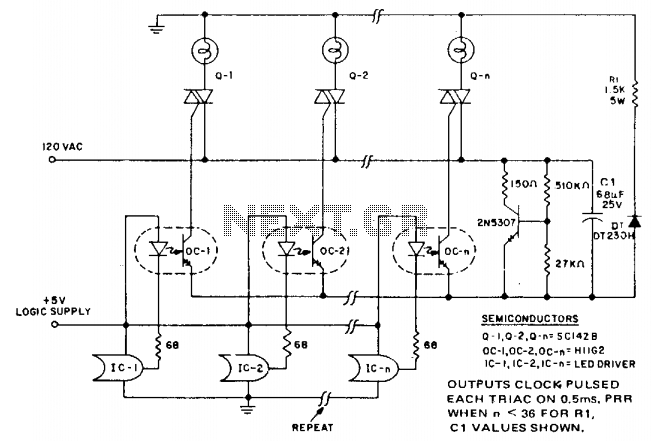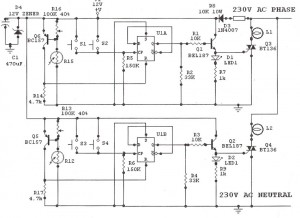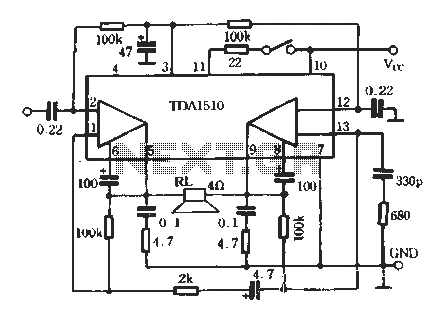
Triac Applications

Next to SCR, the triac is the second most commonly used component in the thyristor family. It has largely replaced SCR in many control applications due to its bidirectional conductivity. Key applications include motor speed regulation, temperature control, illumination control, liquid level control, phase control circuits, and power switches. However, the triac has limitations compared to SCR, particularly regarding turn-off mechanisms. Since the triac can conduct in both directions, forced commutation through reverse-biasing is not applicable. Therefore, turn-off can only be achieved through current starvation, which is often impractical, or by AC line commutation. Currently, commercially available triacs are limited to 200 A and 1,000 PRV. One limitation is the frequency handling capability, which is affected by the dv/dt at which the triac remains in a blocking state without a gate signal. This dv/dt value is approximately 20 V/μs, compared to around 200 V/μs for SCRs, resulting in a frequency limitation at the power level of 50 Hz. Additionally, the same dv/dt limitation implies that the controlled load should preferably be resistive. In high-frequency applications with high dv/dt, back-to-back SCRs cannot be substituted with triacs. The use of a triac as an AC on/off switch is illustrated in a diagram. When the switch S is in position 1, the triac is turned off, and the lamp remains dark. When the switch is moved to position 2, a small gate current flows through the gate, turning the triac on and illuminating the lamp at its rated output. A triac control circuit is depicted, controlling AC power to a load by switching on and off during both the positive and negative half cycles of the input sinusoidal signal. During the positive half cycle, diode D1 is forward-biased, D2 is reverse-biased, and the gate terminal is positive relative to A1. During the negative half cycle, diode D2 is forward-biased while diode D1 is reverse-biased, making the gate positive relative to terminal A2. The point at which conduction begins is adjustable by modifying the resistance R2.
The triac is a crucial component in various electronic control systems due to its ability to manage AC loads effectively. Its operation relies on the principle of gate triggering, where a small control signal at the gate terminal allows the device to conduct current in both directions. This bidirectional capability is particularly beneficial in applications requiring the control of AC power, as it simplifies the circuit design compared to using two SCRs in a back-to-back configuration.
In practical applications, the triac is often integrated into control circuits that require precise timing and control over the load. For example, in a motor speed control circuit, the triac can modulate the power supplied to the motor by adjusting the firing angle, thereby controlling the average voltage and current. This technique is commonly used in light dimmers and heating elements, where the power level needs to be varied.
The design of a triac-based control circuit typically includes protective components such as snubber circuits to manage voltage spikes and prevent damage to the triac. Additionally, heat sinks may be employed to dissipate heat generated during operation, ensuring the device operates within its specified limits.
When implementing a triac in a circuit, careful consideration must be given to the load characteristics and the required switching frequency. The limitations of dv/dt and the maximum current ratings must be adhered to in order to ensure reliable operation. Proper selection of components, including the gate resistor and snubber circuit, will enhance the performance and longevity of the triac in the application.
Overall, the versatility and efficiency of the triac make it an indispensable element in modern electronic control systems, capable of handling various loads and providing reliable performance in a wide range of applications.Next to SCR, the triac is the most widely used member of the thyristor family. In fact, in many of control applications, it has replaced SCR by virtue of its bidirectional conductivity. Motor speed regulation, temperature control, illumination control, liquid level control, phase control circuits, power switches etc.
are some of its main applicati ons. However, the triac is less versatile than the SCR when turn-off is considered. Becausethe triac can conduct in either direction, forced commutation by reverse-biasing cannot beemployed. So turn-off is either by current starvation, which is usually impracticable, orelse by ac line commutation.
There are two limitations enforced on the use of triac at present state of commercially available devices (200 A and 1, 000 PRV). The first is the frequency handling capability produced by the limiting dv/dt at which the triac remains blocking when no gate signal is applied.
This dv/dt value is about 20 Vmicros-1 compared with a general figure of 200 Vmicro s-1 for the SCR, so that the limitation of frequency is at the power level of 50 Hz. The same dv/dt limitation means the load to be controlled is preferably a resistive one. When high frequencies and high dv/dt are involved then the back-to-back SCRs cannot be replaced by the triac.
Use of the triac as an ac on/off switch is shown in figure. When the switch S is in position 1, the triac is cut-off and so the lamp-is`dark. When the switch is put in position 2, a small gate current flowing through the gate turns the triac on and so the lamp is switched on to give rated output. A triac control circuit is shown in figure. Here it is controlling ac power to load by switching on and off during the positive and negative half cycles of the input sinusoidal signal.
During the positive half cycle of the input voltage, diode D1 is forward biased, D2 is reverse-biased, and the gate terminal is positive with respect to A1 During the negative half cycle, the diode D2 is forward biased and diode D1 is reverse-biased, so that the gate becomes positive with respect to terminal A2- The point of commencement of conduction is controlled by adjusting the resistance R2. 🔗 External reference
The triac is a crucial component in various electronic control systems due to its ability to manage AC loads effectively. Its operation relies on the principle of gate triggering, where a small control signal at the gate terminal allows the device to conduct current in both directions. This bidirectional capability is particularly beneficial in applications requiring the control of AC power, as it simplifies the circuit design compared to using two SCRs in a back-to-back configuration.
In practical applications, the triac is often integrated into control circuits that require precise timing and control over the load. For example, in a motor speed control circuit, the triac can modulate the power supplied to the motor by adjusting the firing angle, thereby controlling the average voltage and current. This technique is commonly used in light dimmers and heating elements, where the power level needs to be varied.
The design of a triac-based control circuit typically includes protective components such as snubber circuits to manage voltage spikes and prevent damage to the triac. Additionally, heat sinks may be employed to dissipate heat generated during operation, ensuring the device operates within its specified limits.
When implementing a triac in a circuit, careful consideration must be given to the load characteristics and the required switching frequency. The limitations of dv/dt and the maximum current ratings must be adhered to in order to ensure reliable operation. Proper selection of components, including the gate resistor and snubber circuit, will enhance the performance and longevity of the triac in the application.
Overall, the versatility and efficiency of the triac make it an indispensable element in modern electronic control systems, capable of handling various loads and providing reliable performance in a wide range of applications.Next to SCR, the triac is the most widely used member of the thyristor family. In fact, in many of control applications, it has replaced SCR by virtue of its bidirectional conductivity. Motor speed regulation, temperature control, illumination control, liquid level control, phase control circuits, power switches etc.
are some of its main applicati ons. However, the triac is less versatile than the SCR when turn-off is considered. Becausethe triac can conduct in either direction, forced commutation by reverse-biasing cannot beemployed. So turn-off is either by current starvation, which is usually impracticable, orelse by ac line commutation.
There are two limitations enforced on the use of triac at present state of commercially available devices (200 A and 1, 000 PRV). The first is the frequency handling capability produced by the limiting dv/dt at which the triac remains blocking when no gate signal is applied.
This dv/dt value is about 20 Vmicros-1 compared with a general figure of 200 Vmicro s-1 for the SCR, so that the limitation of frequency is at the power level of 50 Hz. The same dv/dt limitation means the load to be controlled is preferably a resistive one. When high frequencies and high dv/dt are involved then the back-to-back SCRs cannot be replaced by the triac.
Use of the triac as an ac on/off switch is shown in figure. When the switch S is in position 1, the triac is cut-off and so the lamp-is`dark. When the switch is put in position 2, a small gate current flowing through the gate turns the triac on and so the lamp is switched on to give rated output. A triac control circuit is shown in figure. Here it is controlling ac power to load by switching on and off during the positive and negative half cycles of the input sinusoidal signal.
During the positive half cycle of the input voltage, diode D1 is forward biased, D2 is reverse-biased, and the gate terminal is positive with respect to A1 During the negative half cycle, the diode D2 is forward biased and diode D1 is reverse-biased, so that the gate becomes positive with respect to terminal A2- The point of commencement of conduction is controlled by adjusting the resistance R2. 🔗 External reference





